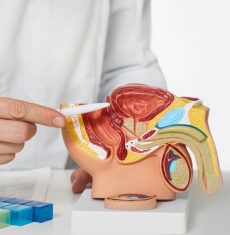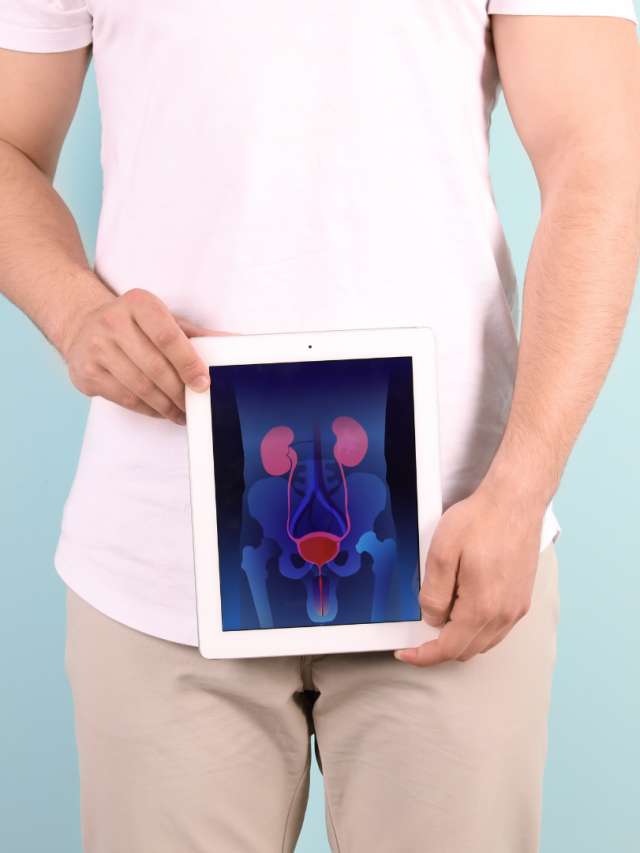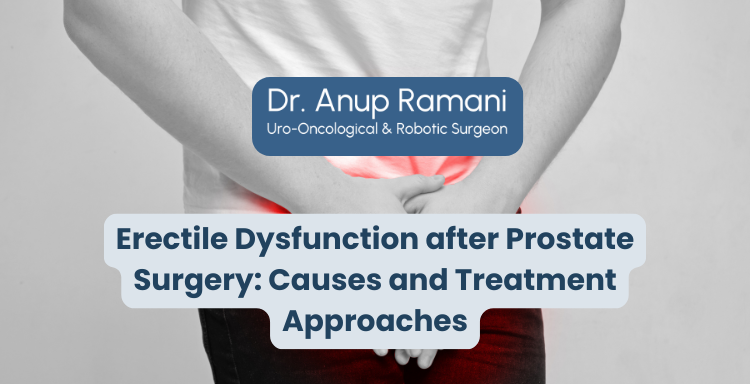Dr Anup Ramani @ Copyright 2024
By Dr. Anup Ramani
Erectile dysfunction (ED) is a common post-surgery concern for patients undergoing prostate cancer treatment. Prostate cancer surgery involves the removal of the prostate gland, which can often lead to complications in erectile function. The condition of ED following prostate cancer surgery can be multifactorial, influenced by nerve damage, impaired blood flow and psychological factors. While advancements such as robotic prostate cancer surgery have made strides in precision, it does not completely negate the possibility of erectile dysfunction.
This article explores into the key causes of erectile dysfunction following prostate surgery and highlights the importance of seeking expert guidance for treatment options.
Causes of Erectile Dysfunction after Prostate Surgery
Erectile dysfunction after prostate cancer surgery arises from a combination of physiological and psychological factors. Each cause contributes to a unique aspect of sexual function and understanding these factors is essential for patients navigating their post-surgery recovery. Below, we explore the main causes of erectile dysfunction after prostate cancer surgery.
Nerve Damage during Surgery
The most significant cause of erectile dysfunction after prostate surgery is nerve damage. The prostate is located near crucial erectile nerves that are responsible for the ability to achieve and maintain an erection. During a radical prostatectomy, which is the surgical removal of the prostate gland, these nerves can be damaged or cut in the process of removing the prostate.

In prostate cancer surgeries, particularly when the prostate is removed to treat cancer, the preservation of these neurovascular bundles, which contain erectile nerves, becomes a crucial consideration. However, even with advancements like robotic prostate cancer surgery, which allows for greater precision in preserving these nerves, the risk of damage remains. The extent of nerve damage can vary depending on factors like the surgeon’s skill, the patient’s anatomy, the stage of cancer and whether the cancer has affected these nerves. Despite the precision of robotic radical prostatectomy, some degree of nerve damage is inevitable for certain patients, which can result in temporary or permanent erectile dysfunction.
Compromised Blood Flow to the Penis
Blood flow plays a critical role in achieving an erection. The prostate helps regulate the blood flow to the penis, especially during sexual arousal. When the prostate is removed during prostate cancer surgery, the normal flow of blood to the penis can be disrupted, causing erectile dysfunction.
In addition to surgery, other factors like age, cardiovascular health and pre-existing conditions such as diabetes can further complicate the blood flow to the penile region. These conditions can weaken the vascular system and reduce the capacity for sufficient blood flow during arousal, which is necessary for an erection. As a result, the risk of ED is higher for older patients or those with poor cardiovascular health.
In some cases, this reduction in blood flow can be temporary, but for many men, it can become a persistent problem, especially if the blood vessels and tissue around the prostate area are damaged during the surgery. This highlights the importance of maintaining optimal cardiovascular health before and after surgery to mitigate these risks.
What Our Patients Are Saying
Scar Tissue Formation
Scar tissue or fibrosis can form during the healing process after surgery, which may impede the functioning of erectile nerves and blood vessels. The prostate removal surgery often requires cutting through various tissues and as these tissues heal, scar tissue can develop. Scar tissue around the neurovascular bundles or the penile region can disrupt the transmission of nerve signals required for sexual arousal and erectile function.
In some cases, the scar tissue can directly affect the blood flow to the penis, further exacerbating erectile dysfunction. Additionally, scarring within the erectile tissues of the penis may make the tissue less flexible and restrict the ability of the blood vessels to expand, further impeding normal erectile function. While scar tissue formation is a natural part of the healing process, its potential to negatively impact erectile function should not be underestimated.
Damage to the Urethra
The urethra, the tube that carries both urine and semen, passes through the prostate. During prostate cancer surgery, particularly radical prostatectomy, the urethra may be affected. In some instances, it may be repositioned or surgically altered, which can lead to complications in erectile function.

Damage to the urethra can create physical changes in the surrounding tissues, which may impact sexual function. The most common consequence is the development of erectile dysfunction, as the internal structures supporting sexual arousal may no longer work in the same way. Urethral changes can also result in painful erections or difficulties in achieving an erection, leading to further distress.
Patients undergoing prostate cancer surgery should be aware of the potential changes to the urethra and discuss possible implications for erectile function with their surgical team. It is essential to have regular follow-ups to address any urethral issues post-surgery and to explore available options for treatment.
Hormonal Changes Post-Surgery
Testosterone is a key hormone in the regulation of sexual desire and erectile function. After prostate cancer surgery, particularly when androgen deprivation therapy (ADT) is used to reduce testosterone levels in the body, men may experience a drop in libido and erectile function. ADT is often prescribed to prevent cancer recurrence but can have a significant impact on sexual health.
Even if ADT is not employed, the removal of the prostate gland itself can lead to hormonal changes. The prostate contributes to semen production and hormone regulation and its removal can disturb the body’s balance of testosterone, affecting sexual performance. Because testosterone is integral to maintaining erectile function, hormone imbalances should be closely monitored following surgery.
Psychological and Emotional Factors
The psychological effects of prostate cancer treatment can also significantly contribute to erectile dysfunction. A diagnosis of cancer, followed by surgery, can lead to emotional distress, anxiety, depression and reduced body image, all of which may impact sexual health. Anxiety about sexual performance or concerns about masculinity and sexual identity can worsen the problem.
Psychological factors can interfere with sexual desire and the ability to achieve an erection. The fear of erectile dysfunction itself may contribute to performance anxiety, which can create a vicious cycle of ED. Psychological support is often as important as physical treatments when addressing erectile dysfunction after prostate surgery.
Age and Pre-Surgery Erectile Function
The patient’s age is a significant factor in the likelihood of experiencing erectile dysfunction after prostate surgery. As men age, their sexual function naturally declines due to reduced testosterone levels, diminished blood flow and weakening of the erectile tissues. Men who are older are more likely to experience persistent erectile dysfunction after prostate surgery compared to younger patients.
Furthermore, the presence of pre-existing erectile dysfunction before surgery can increase the chances of ED after the procedure. If a patient had mild erectile dysfunction prior to surgery, they may face more significant difficulties after the prostatectomy.
Conclusion
Erectile dysfunction following prostate cancer surgery is a complex and multifactorial condition. Factors such as nerve damage, compromised blood flow, scarring and hormonal changes all contribute to the development of ED post-surgery. Psychological factors, such as anxiety and stress, further exacerbate the condition. Patients should be aware of these potential causes and engage in open discussions with their healthcare team to assess and address these issues effectively.
While various treatment options are available, consulting with a healthcare provider is crucial to determine the most appropriate course of action based on individual needs. Early intervention and expert guidance can significantly improve post-surgery sexual function and quality of life.
FAQs
What causes erectile dysfunction after prostate surgery?
Erectile dysfunction after prostate surgery is primarily caused by nerve damage, compromised blood flow, scarring, hormonal changes and psychological factors. These causes may vary depending on the type of surgery and the individual’s health.
Can erectile dysfunction after prostate surgery be reversed?
Erectile dysfunction after prostate surgery can often be improved with appropriate treatment, but complete reversal depends on the severity of nerve damage, blood flow disruption and psychological factors.
How long does erectile dysfunction last after prostate surgery?
The duration of erectile dysfunction varies from patient to patient. Some may see improvements in a few months, while others may require longer recovery time. Early intervention can help accelerate recovery.
Is robotic prostate surgery better for preserving erectile function?
Robotic prostate surgery offers greater precision and better nerve-sparing techniques, which can help preserve erectile function. However, the risk of ED still exists depending on several factors such as age and pre-surgery erectile health.
Should I consult a doctor about my erectile dysfunction after surgery?
Yes, it is crucial to consult your healthcare provider about erectile dysfunction after surgery. A tailored treatment plan and early intervention can help address ED and improve sexual health.
About Author

Uro-Oncological & Robotic Surgeon
Dr. Anup Ramani is a robotic uro-oncological surgeon and an internationally recognized expert in robotic surgery for prostate, kidney and urinary bladder cancers. With more than two decades of robotic experience and 2,000+ robotic procedures, he brings unmatched precision and outcomes to complex uro-oncology cases. He is widely published in his field and is known for a personal, transparent approach-often spending over an hour in initial consultations to educate patients on its disease, surgery and recovery. His expertise spans prostate cancer treatment, kidney and bladder cancer surgery, adrenal gland surgery, kidney stone treatment, penile cancer surgery and enlarged prostate management. Dr. Ramani advocates the advantages of robotic surgery-magnified 3D vision, tremor-filtered precision, minimal scarring, lower blood loss and faster recovery-helping patients return to life sooner.
Best Uro-Oncological surgeon
Specialist in India for Robotic Surgery
MCh, DNB, MS, DNB
Dr. Anup Ramani
CONTACT
Uro-Oncologist in India,
Best Robotic Surgeon for Uro Oncology Surgery
1407, One Lodha Place Next to World Towers Senapati Bapat Marg, Worli, Mumbai. 400013.
Dr Anup Ramani @ Copyright 2024 – Website Maintenance, SEO & GEO by Opal Infotech
- Partial penectomy is done in cases where glans and distal penis is involved with carcinoma.
- Partial penectomy is a type of organ-preserving surgery. Preservation of sexual and micturational function depends on the surgical dissection and reconstruction of residual urethra.
- Patients who develop stones in the kidney or ureter, often experience severe pain.
- This condition usually needs a procedure to remove the kidney stones.
- This procedure is called ureteroscopy and is performed very commonly.
- It does not require any cuts and hence it is painless.
- The procedure is performed with an endoscope inserted through the penis under spinal anesthesia.
- The scope is inserted through the penis into the kidney and stones are dissolved with a laser.
- The procedure takes about 40-50 minutes.
- A catheter (urine pipe) is kept after the procedure to drain the bladder. A stent is kept in the kidney at the same time.
- Patient is mobile and walking in the room the same evening.
- Hospital stay is one night and patient is discharged the next day after removal of the catheter.
- Patient has to come back after six weeks to remove the stent in the kidney.
- Patients can resume office a week after surgery and heavy activities like running, weight lifting, a month after the procedure.
- We offer fixed packages for this procedure which can be obtained by calling our helpline +91 9967666060.
- Men with an enlarged prostate, which is a normal ageing changes, often experiencing difficulty passing urine. This condition usually needs a procedure to trim the prostate and relieve the blockage.
- This procedure is called TURP and is performed very commonly.
- It does not require any cuts and hence it is painless.
- The procedure is performed with an endoscope inserted through the penis under spinal anaesthesia.
- The overgrown prostate is dissolved with a laser bloodlessly.
- The procedure takes about 40 minutes.
- A catheter (urine pipe) is kept after the procedure to drain the bladder.
- Patient is mobile and walking in the room the same evening.
- Hospital stay is two nights and patient is discharged with the catheter, which is removed after 4 days.
- Patients can resume office a week after surgery and heavy activities like running, weight lifting, a month after the procedure.
- We offer fixed packages for this procedure which can be obtained by calling our helpline +91 9967666060.
-
Robotic adrenalectomy is a sophisticated, complex surgery and it is very important that an experienced surgeon performs this surgery to avoid major complications.
-
Once the anesthesia is done, and patient positioned, three micro cuts (3mm each) are made in the patient’s abdomen.
-
The arms of the Da Vinci robot are connected to the cuts via ports (tubes).
-
Dr. Ramani then sits in the controlling console to perform the surgery.
-
On an average, a robotic adrenalectomy takes one hour.
-
The surgery is almost completely bloodless and there has never been any need to transfuse blood after surgery.
-
A urine catheter and bag to drain the bladder is inserted during surgery.
-
A tiny drain pipe may be inserted in the surgical side of the abdomen, connected to a bag.
-
Patient is kept nil-by-mouth the day of the surgery, with IV fluids. Sips of water are started the next day and solid food by day three.
-
The drain pipe, if kept, is removed in the room on day 2 after surgery.
-
The catheter is removed on day two after surgery.
-
Total hospital stay for robotic adrenalectomy is 4 nights (including night before surgery).
-
Post discharge, a doctor from the surgical team visits the patient at home/ hotel room once every day.
On the day of discharge, patient is totally self-sufficient. They are able to walk freely without any pain, dress themselves, shower, toilet and they do not need to hire any nurse or help at home. Almost all patients are back to work within 2 weeks of surgery.
Heavy activities like running, weight lifting can be resumed after a month
Follow up after an adrenalectomy is in the form of CT scans, once a year for 5 years.
Local patients usually meet Dr. Ramani after two weeks to discuss report.Outstation patients are counselled on a phone consultation.
- Dr. Ramani is one of the very few surgeons in India who has the expertise to perform a robotic surgery for bladder cancer, which includes removing the urinary bladder and reconstructing a new bladder robotically.
- Robotic radical cystectomy is an extremely sophisticated, complex surgery and it is very important that an experienced surgeon performs this surgery to avoid major complications.
- Once the anaesthesia is done, and patient positioned, six micro cuts (3mm each) are made in the patient’s abdomen.
- The arms of the Da Vinci robot are connected to the cuts via ports (tubes).
- Dr. Ramani then sits in the controlling console to perform the surgery.
- On an average, a robotic radical cystectomy with an ileal conduit takes 3-4 hours.
- The surgery is almost completely bloodless and there has never been any need to transfuse blood after surgery.
- A urine catheter and bag to drain the new bladder is inserted during surgery.
- Two tiny drain pipe in inserted in the surgical side of the abdomen, connected to a bag.
- Patient is kept nil-by-mouth for 4 days after surgery with IV supplementation of patient’s daily requirements of calories, fats, carbohydrates, proteins and electrolytes.
- The drain pipes are removed in the room on day 3-5 after surgery.
- Total hospital stay for radical cystectomy is 8 nights (including night before surgery).
- Post discharge, a doctor from the surgical team visits the patient at home/ hotel room once every day.
- On the day of discharge, patient is totally self-sufficient. They are able to walk freely without any pain, dress themselves, shower, toilet and they do not need to hire any nurse or help at home.
- Almost all patients are back to work within 6 weeks of surgery. Heavy activities like running, weight lifting can be resumed after two months.
Follow up after a radical a cystectomy is in the form of CT scans, once a year for 5 years.
Histopathology report: Local patients usually meet Dr. Ramani after two weeks to discuss report.
Outstation patients are counselled on a phone consult. Depending on the report, patient may or may not need chemotherapy after surgery.
If chemo is needed, patients may choose to get it done with a medical oncologist of their choice or avail the services of one of the four medical oncologists on our team.
- Robotic partial nephrectomy is a sophisticated, complex surgery and it is very important that an experienced surgeon performs this surgery to avoid major complications. Robotic radical (total) nephrectomy is
- relatively easier but still requires significant experience to consistently deliver results.
- Once the anaesthesia is done, and patient positioned, five micro cuts (3mm each) are made in the patient’s abdomen.
- The arms of the Da Vinci robot are connected to the cuts via ports (tubes).
- Dr. Ramani then sits in the controlling console to perform the surgery.
- On an average, a robotic radical nephrectomy takes one hour and a robotic partial nephrectomy takes about an hour and half.
- The surgery is almost completely bloodless and there has never been any need to transfuse blood after surgery.
- A urine catheter and bag to drain the bladder is inserted during surgery.
- A tiny drain pipe in inserted in the surgical side of the abdomen, connected to a bag.
- Patient is kept nil-by-mouth the day of the surgery, with IV fluids. Sips of water are started the next day and solid food by day three.
- The drain pipe is removed in the room on day 3 after surgery. The catheter is removed on day two after surgery.
- Total hospital stay for radical/partial nephrectomy is 4 nights (including night before surgery).
- Post discharge, a doctor from the surgical team visits the patient at home/ hotel room once every day.
- On the day of discharge, patient is totally self- sufficient.
- They are able to walk freely without any pain, dress themselves, shower, toilet and they do not need to hire any nurse or help at home.
- Almost all patients are back to work within 2-3 weeks of surgery.
- Heavy activities like running, weight lifting can be resumed after a month.
- Follow up after a radical/partial Nephrectomy is in the form of CT scans, once a year for 5 years.
- Local patients usually meet Dr. Ramani after two weeks to discuss report.
- Outstation patients are counselled on a phone consultation.





